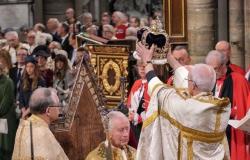The place where, for almost two centuries, the reliquary with the relics of the Holy Great Martyr John the New, the Church of the Mirăuți Monastery, a voivodeal foundation from the 14th century, the first cathedral of the Metropolitanate of Moldova, has put on festive clothes, this year the day of commemoration of the Holy Great Martyr George, the spiritual patron of the holy place, being an occasion for triple joy, by writing special moments in the pages of history. With the blessing of His Eminence Father Calinic, Archbishop of Suceava and Rădăuți, on the 435th anniversary of the transfer of the relics of Saint John to the new Metropolitan Cathedral, the precious scent of the Suceava Citadel returned to Mirăuți to mark the celebration of the patron saint who also enjoyed bishop’s blessing.
At the celebration hour, Tuesday, April 23, 2024, among the believers present were the Most Reverend Father Benedict Bistrițeanul, Bishop-Vicar of the Archdiocese of Vad, Feleac and Cluj, and the Most Reverend Father Damaschin Dorneanul, Bishop-Vicar of the Archdiocese of Suceva and Rădăuțil. After they were welcomed in the ringing of bells, according to custom, with bread and salt, but also with flowers, by a council of priests and deacons and the monastic community led by the archim. Haralambie Țanef, the abbot of the Mirăuți Monastery, the bishops worshiped the holy relics of the Holy Great Martyr John the New, located on the occasion of the patron saint in what was the Metropolitan Cathedral of Moldova between 1402-1522.
The two hierarchs then performed the Holy Liturgy of the previously sanctified Gifts on a special podium set up within the monastic complex, together with a council of priests and deacons of which the archbishop was a part. Dosoftei Dijmărescu, cultural exarch of the Archdiocese of Suceva and Rădăuţi, Fr. Dimitrie Horga, administrative adviser, Fr. Ionel Doru Budeanu, archpriest of the Suceava I Archdiocese. The liturgical responses were given by the Psaltic Group of the Orthodox High School Theological Seminary “Metropolitan of Dosoftei” from Suceava, led by the archbishop. Paul Iusca.
After reading the text of the Holy Scripture, the Most Reverend Father Benedict of Bistrițeanu spoke a word of teaching in which he evoked good luck of the Holy Great Martyr George, remembered by hymnographers in one of the verses of the Vespers dedicated to the bearer of victory. His Eminence also highlighted the fact that only through a perfect love, reflected in every deed, the Christian can lead a life pleasing to God, like Saint George, who deserved to receive the crown of martyrdom, confessing Christ.
“What is important, beyond everything we do and everything that happens, is love because only love can introduce us to the Mystery of God, the Mystery of the Kingdom and the meanings of the world. Therefore, the good need it presupposes precisely the cultivation of love and this exercise in which we grow in love towards those around us. Saint George bore this good need because he grew in love. His sacrifice was the result of his love for God, but also for people because he did not receive a martyr’s death by judging those who killed him, he did not receive a martyr’s death by condemning sinners and unbelievers, he did not receive a martyr’s death by counting privileged himself over those around him, but received this martyrdom for love of God, putting the love of God first, but at the same time receiving death for himself and for the whole world. (…) Saint George died for love, for love of God, but also for love of neighbor. He died and with him suffered this martyrdom and all those who live the suffering on earth, live the insecurity on earth, live the pain of the lack of love of others towards them. I once again emphasize the face that the hymnography reveals to us regarding Saint George. He made the good effort because his life and his martyrdom were accompanied and manifested by the love in which he was and in this way it was shown sacrifice acceptable to God.”
At the end of the service, His Holiness Father Benedict Bistrițeanul ordained two servants as archdeacons, and two hieromonks from the community of Mirăuți Monastery became Proto-Singhile through the hands of His Holiness Father Damaschin Dorneaul.
On behalf of His Eminence, Archbishop Calinic, awards of merit were given to the benefactors and supporters of the work of the Church, as a sign of appreciation and gratitude for the special merits in the promotion and support of Romanian Orthodox Christian values. Archim. Dosoftei Dijmărescu read the text Order of the “Holy Great Martyr John the New from Suceava”, and the Most Reverend Father Damaschin Dorneanul handed out the awards to the clerics close to the monastery and the servants, among whom Fr. Prof. Dr. Gheorghe-Florin Hostiuc, Prof. Dr. Gheorghe Hostiuc and Fr. Dr. Ionel-Mugurel Martiniuc.
Order “Cross of Bucovina”, the highest distinction of the Archdiocese of Suceava and Rădăuţi, was presented to the abbot of the Mirăuți Monastery, archim. Haralambie Țanef, for “remarkable activity in the service of the Church”. He spoke to those present about the power and love of the martyrs who can be an example of prayer and spiritual living even today, including Saints George and John the New, who intercede for all humanity before the Throne of the Most Holy Trinity. The father abbot then thanked all those who joined in prayer on this special day, the father bishops, the council, the choir and all the pilgrims and worshippers, as well as the local chiriarch for ordering that the protector of the Suceava Citadel rest in this holy place
“We express our thanks to His Holiness Father Calinic, Archbishop of Suceava and Rădăuțil, who kindly accepted the old Metropolitan Cathedral Saint George from Mirăuți, where the metropolitans were ordained and enthroned and where the rulers of Moldavia were anointed with the Holy and Great Mir, among whom the Holy Voivode Stefan the Great is in the place of honor, may he receive the due honor for what was, is and will remains for centuries, this symbol of the ancestral faith, but also a symbol of the culture and history of the Romanian people, especially for the Land of Moldavia and Suceava, and our Bucovina, with all the Northern Land across the border and the whole of Bessarabia. By blessing the bringing of the holy relics of the Holy Great Martyr John the New after 435 years, His Holiness Calinic tied the thread of history and faith between those of that time and those who are present here today, at a special historical moment for the life of our Orthodox Church and the Romanian people.”
As a sign of gratitude for the bishop’s visit, the father offered the present hierarchs an icon with the face of the Mother of the Cathedral, respectively with the representation of the Savior Jesus Christ. At the same time, the abbot reminded that the joy of the patron saint will be crowned by a special pre-Easter concert, “Offering of Crucified Love”, supported by the “Dimitrie Suceveanu” Psaltic Group of the Archbishop’s Cathedral in Suceava, starting at 18:00, in the Mirăuți Church.
On the occasion of these days of celebration, at the first consecration of the holy place after its re-establishment as a monastic settlement in the fall of 2023 by His Eminence Father Calinic, Archbishop of Suceava and Rădăuţil, the community of the monastery, with the support of the Suceava Diocesan Center and the Publishing House Crimca, took care of the appearance of a presentation brochure that brings to attention the most important aspects of the architectural history and the pictorial clothing of the monument, the text being signed by the arch. Vasile Demciuc, Councilor of the Sector Monuments, Heritage and Church Architecture.
“Mirăuţi Monastery needed – after all this time – the joy, the light and the brilliance that it had when it was the Metropolitan Cathedral of Moldova, where the rulers received, after the election by The Council of the Country, religious consecration by anointing with Holy Mir. The metropolitan from whose hands the rulers received their religious consecration was the only person able to legitimize in this cathedral, like the Byzantine patriarchs of old, the choice made by The Council of the Country. And there were so many rulers who received this consecration in the Church Saint George the Great Martyr of the Mirăuţi Monastery, a church whose patron was supposed to be an exhortation to victory.”
Short history
“The history of this holy monastery begins, as historical testimonies prove, somewhere in the distant past of the 14th century, starting from a hermitage in the centuries-old woods guarding the Suceava river, reaching a voivodeship founding monastery, which had to arrive in time the first cathedral of the Metropolis of Moldova, recognized by Tomos Synod by the Ecumenical Patriarchate of Constantinople on July 26, 1401, during the reign of Alexander the Good. The first Metropolitan of Moldova was Iosif I Mușat, a close relative of Voivode Petru Mușat, and the first concern of the metropolitan was to bring to Suceava the relics of Saint John the New, which had been, for almost a century, in the White Citadel, in fact which happened in 1402.
The two events: the establishment of the Metropolis with its residence in Suceava, the capital of the country, and the bringing of the relics of Saint John the New meant for the people and the leader unity, hope, protection and the crowning of the desire of this faithful people to have an independent church, a support for the voivode and a special spiritual center in this part of Moldova. The years have passed, and many deeds of dignity and living in the right faith have been recorded by history under the leadership of the great metropolitans of the Country of Moldova, among whom we mention some of the descendants of Joseph I Mușat: Damian, Teoctist I, Teoctist II, Grigorie Roșca , Anastasie and others who resided in Suceava until the residence of the Metropolitans of Moldova was moved to Iasi.
However, years also followed in which the vicissitudes of time caused this monastery to be abandoned and left in disrepair. At the beginning of the 20th century, following the restoration works, the Mirăuți Church was placed under the supervision of the Monastery of Saint Ioan cel Nou from Suceava, which took care of the services here. This status continued until the communist period, with a small interruption between 1919-1926, when the Monastery of Saint John the New handed over the site to the Parish of Saint Dumitru – Suceava.” (Arch. Haralambie Țanef, abbot of the Mirăuți Monastery)
More photos HERE
Author: Irina Ursachi / Archdiocese of Suceava and Rădăuțil
Photo credit: Ionuț Chifa / Metropolis of Cluj
Tags: Metropolitan Cathedral Moldova Mirauti Monastery honored patron
-





